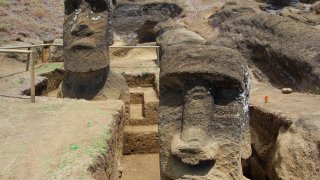
“View from downslope of two Moai during excavations by Jo Anne Van Tilburg and her team at Rano Raraku quarry, Rapa Nui.”
A researcher has offered a new theory for the mystery of Easter Island’s stone heads, arguing in a recent study that carvers believed they helped the growth of crops.
Soil tests of the Rano Raraku quarry, where almost all the island’s more than 1,000 Moai monoliths originated, found that the area was ideal for agriculture, according to a news release from the University of California, Los Angeles. The quarry’s soil is rich with nutrients, thanks to a local fresh water source and the quarrying process itself, and contains evidence of the cultivation of crops such as banana, taro and sweet potato.
Jo Anne Van Tilburg, director of the Easter Island Statue Project and UCLA’s Rock Art Archive, has led a team studying two Moai excavated in Rano Raraku. Both statues were found upright, though almost completely buried, supporting her theory that the indigenous Rapanui builders intended them to remain in the quarry.
“This study radically alters the idea that all standing statues in Rano Raraku were simply awaiting transport out of the quarry,” Van Tilburg said in the UCLA release. “That is, these and probably other upright Moai in Rano Raraku were retained in place to ensure the sacred nature of the quarry itself. The Moai were central to the idea of fertility, and in Rapanui belief their presence here stimulated agricultural food production.”
The monoliths are hundreds of years old, with the statues Van Tilburg and her team are working with estimated to have been built by or before A.D. 1510 to A.D. 1645.
Van Tilburg’s theory, which includes an understanding of the ancient Rapanui as intuitive farmers, is a contribution to an ongoing debate over the history of the island’s population. One common but controversial theory is that a population decline occurred due to the people’s overexploitation of natural resources before the arrival of European explorers, according to the University of Hawai’i.
However, research conducted by the university in 2017 suggested that the Rapanui adapted to their harsh environment, constructing gardens to grow crops despite nutrient-poor soils.
Local
Get Los Angeles's latest local news on crime, entertainment, weather, schools, COVID, cost of living and more. Here's your go-to source for today's LA news.
Van Tilburg’s study sheds further lights on the population’s agriculture – and its connection to the Moai.
“Our excavation broadens our perspective of the Moai and encourages us to realize that nothing, no matter how obvious, is ever exactly as it seems. I think our new analysis humanizes the production process of the Moai,” Van Tilburg said in the UCLA release.